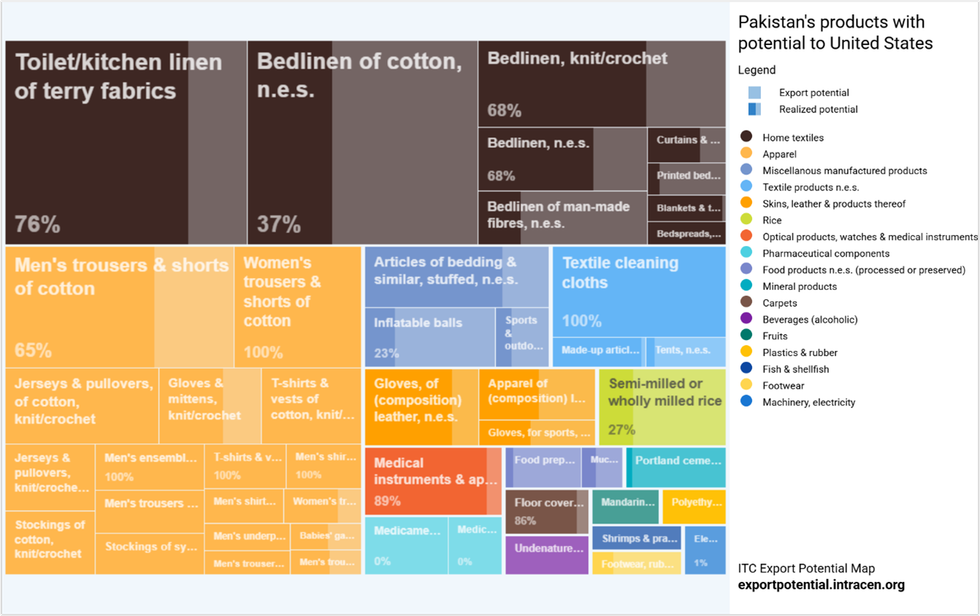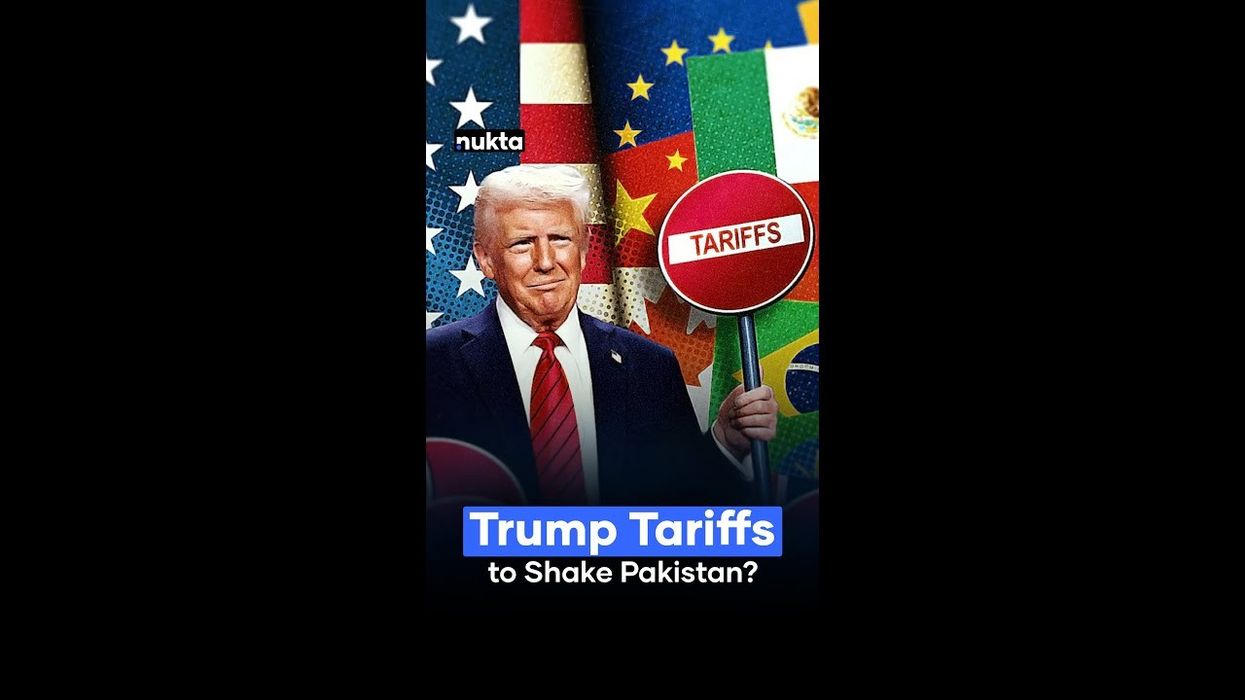How do Trump's tariffs affect Pakistan?
Pakistan faces 29% tariff rate as Trump declares national emergency
Nida Gulzar
Research Analyst
A distinguished economist with an M. Phil. in Applied Economics, Nida Gulzar has a strong research record. Nida has worked with the Pakistan Business Council (PBC), Pakistan Banks' Association (PBA), and KTrade, providing useful insights across economic sectors. Nida continues to impact economic debate and policy at the Economist Intelligence Unit (EIU) and Nukta. As a Women in Economics (WiE) Initiative mentor, she promotes inclusivity. Nida's eight 'Market Access Series papers help discover favourable market scenarios and export destinations.
Countries around the world, including Pakistan, are shocked. In a sweeping move, U.S. President Donald Trump has announced a slew of reciprocal tariffs. Markets have sunk, commodities have slid, and safe-haven gold is up.
"We subsidize a lot of countries and keep them going and keep them in business," Trump said about trade partners, specifically Mexico and Canada. "Why are we doing this? I mean, at what point do we say you got to work for yourselves? In many cases, the friend is worse than the foe in terms of trade," the U.S. president stated.
The U.S. has adjusted tariff rates in response to various factors, including trade imbalances and perceived unfair practices. For instance, countries like China and Taiwan have been subjected to tariffs as high as 34% under the new policy.
It's important to note that these tariff rates are subject to change based on ongoing trade negotiations and geopolitical considerations.
But what does this new regime mean for Pakistan – the country that is the third largest South Asian exporter of textile products to the U.S. (3.5% of the total U.S. textile imports as of 2024).
Pakistan is included in the list of approximately 60 countries facing higher tariffs, with an imposed tariff rate of 29%, in retaliation of the 58% rate charged to the US.
Pak-U.S. trade partnership
Pakistan and the U.S. share a longstanding trade partnership, with the U.S. as a key export market. In FY24, bilateral trade hit $7.3 billion, including $5.4 billion in Pakistani exports. Pakistan benefits from Most Favored Nation trade status and the U.S. GSP program, allowing duty-free exports of over 3,500 products. For the fiscal year 2024-25 (FY25), Pakistan has exported products worth $4.0 billion to the U.S.
The top 10 categories at the HS-02 level of U.S. imports from Pakistan are valued at $4.8 billion, contributing a share of 88.6% to total U.S. imports from Pakistan. According to the ITC Trade Map’s data, Pakistan is a major supplier of made-up articles accounting for 28.7% of total exports made to the U.S. in 2024. Other prominent categories include apparel, cotton, and leather articles.
Pakistan’s aggregate trade potential to the U.S. for the 20 high potential commodities (at the HS-06 level) amounted to approximately $2.8 billion in 2023. A 29% potential tariff could hinder the growth in the estimated amount.

Bilateral market access and tariff reciprocity: implications for US imports
Reciprocal tariffs are measures imposed by a country in response to tariffs placed on its exports by another nation.
“Reciprocal means that if a country has higher tariffs than we do on certain products, we would raise it to that level," according to Alex Jacquez, chief of policy and advocacy at Groundwork Collaborative, a left-leaning public policy think tank.
Specific sectors facing higher tariffs on U.S. imports include:
- Agricultural Products: Items like wheat, soybeans, and dairy products are subject to elevated tariffs to safeguard Pakistan's agricultural sector.
- Textiles and Apparel: Higher tariffs are imposed to support the local textile industry, a significant contributor to Pakistan's economy.
- Automobiles: Increased tariffs on U.S. automobile imports aim to encourage the development of domestic automobile manufacturing.
- Machinery and Equipment: Elevated tariffs are applied to promote growth in local manufacturing and industrial sectors.
The average tariff on the U.S. products imported by Pakistan is 13.5% across 97 chapters, with the highest tariff of 59%, but some categories face much higher duties:
However, the average tariff on products imported into the U.S. from Pakistan across 97 chapters is 2.4%, with the highest tariff of 27%.
Tariff Applied by the U.S. on Pakistan
Pakistan’s average applied tariff on U.S. goods is around 11-18%, but some categories face much higher duties:
Pakistan exports of textiles
Although Pakistan stands as the 7th largest exporter of textiles and apparel to the U.S., the U.S. remains Pakistan's most significant trade partner, accounting for 25.5% of the country's textile exports.
This substantial share highlights the crucial role of the U.S. in Pakistan’s textile sector. A notable portion of this export is yarn, which is shipped to the U.S., where it is further processed and transformed into value-added textile products.
In 2024, both Pakistan and the U.S. were ranked as the 12th and 13th largest exporters of apparel and made-up textiles, respectively, underscoring the trade complementarities and the competitive nature and of the global textile market.
Despite being a significant exporter, Pakistan holds only a 3% share of the total U.S. textile imports, ranking 8th among U.S. textile suppliers. This relatively small share presents a clear opportunity for growth, with an indicative trade potential valued at $3.6 billion.
Moreover, exports under the U.S. Generalized System of Preferences (GSP) scheme have exceeded $4 billion, further reflecting the untapped potential and the strategic importance of strengthening trade ties between the two countries.
Pakistan employs the Harmonized System (HS) for product classification, using eight-digit codes (tariff lines) where the first two digits represent the chapter, indicating broad product categories. Customs duties are applied on an ad-valorem basis, and an additional 17% sales tax is levied on the duty-paid value of various goods produced in or imported into the country.
The United States and Pakistan entered into a trade and investment framework agreement (TIFA) in June 2003. This agreement serves as the primary platform for discussions on trade and investment matters between the two nations.
In 2023, Pakistan's average Most-Favored-Nation applied tariff rate was 10.3%, with agricultural products facing a higher average rate of 13% compared to 9.9% for non-agricultural goods.
Pakistan faces a 29% tariff under Trump’s reciprocal tariff regime but still holds an advantage over regional peers like Bangladesh (37%) and Sri Lanka (44%), which are also affected. Despite previous tariff reductions, U.S. firms have raised concerns over Pakistan’s high duties and regulatory practices.
The country continues using statutory regulatory orders (SROs) for exemptions and protections, despite IMF commitments to phase them out. While trade pressures rise, Pakistan's position within the tariff framework remains relatively better than some competitors.
Implications for Trade
The imposition of reciprocal tariffs can lead to several outcomes:
- Trade diversion: Businesses may seek alternative markets to mitigate tariff impacts.
- Price adjustments: Importers might adjust pricing strategies to accommodate increased costs.
- Negotiation incentives: Such tariffs can serve as leverage in trade negotiations, aiming for more favorable terms.
Pakistan's reciprocal tariffs on U.S. products are strategically implemented to protect and promote domestic industries. Stakeholders engaged in U.S.-Pakistan trade must stay informed about these tariffs and utilize available resources to navigate the evolving trade landscape effectively.











Comments
See what people are discussing